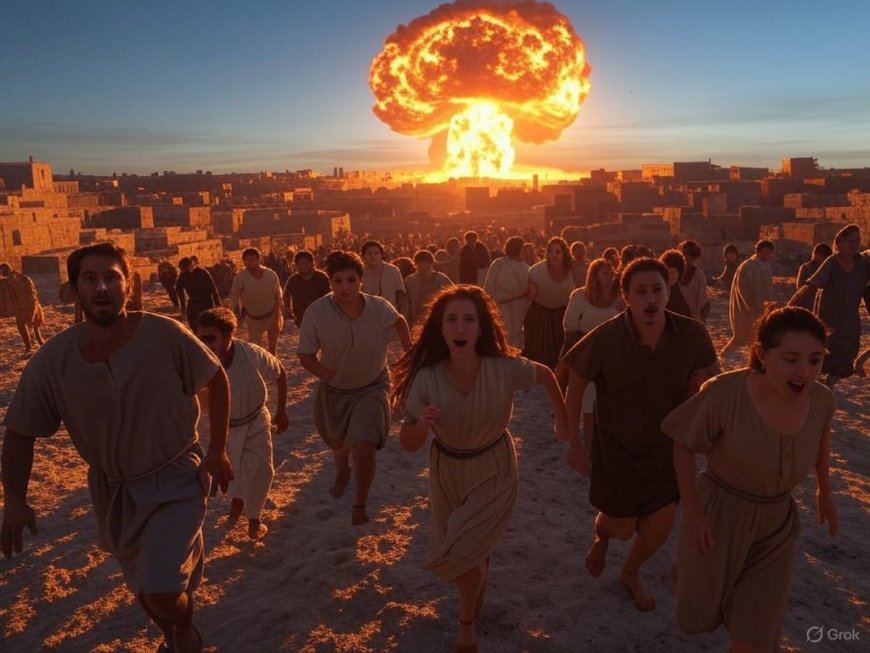The idea of ancient nuclear warfare might sound like the plot of a science fiction blockbuster, but over the years, researchers and enthusiasts alike have pointed to intriguing evidence suggesting that civilizations long before our time might have harnessed atomic power—or suffered its consequences. From mysterious ruins to elevated radiation levels, the theories surrounding ancient nuclear warfare have sparked debates among archaeologists, historians, and scientists. Could these findings challenge our understanding of human history? Let’s dive deep into the evidence, explore the theories, and separate fact from speculation.
The Origins of the Ancient Nuclear Warfare Hypothesis
The notion that ancient civilizations might have wielded nuclear technology first gained traction in the mid-20th century, particularly after the atomic bombings of Hiroshima and Nagasaki. Some scholars began re-examining ancient texts and archaeological sites with a new lens, wondering if descriptions of catastrophic events could align with nuclear explosions. One of the most cited sources is the Indian epic Mahabharata, which describes a weapon with the power of "a thousand suns" that reduced an entire race to ashes. While traditionally interpreted as mythological, some argue these passages mirror the effects of a nuclear blast, including radiation poisoning and widespread destruction.
Similarly, ancient Sumerian and Egyptian texts mention "evil winds" and "great fires from the sky," which some theorists link to nuclear fallout. These interpretations, however, remain controversial, as mainstream historians often attribute such accounts to natural disasters, volcanic eruptions, or exaggerated storytelling.
Key Archaeological Sites and Evidence of High Radiation
Several archaeological sites have fueled the ancient nuclear warfare debate, with claims of unusually high radiation levels and physical anomalies. Here are the most notable examples:
1. Mohenjo-Daro, Pakistan
Discovered in the 1920s, the ruins of Mohenjo-Daro, part of the Indus Valley Civilization, have long puzzled researchers. Excavations revealed skeletons scattered across the streets, some appearing to have died instantly while holding hands. Proponents of the nuclear theory point to reports of elevated radiation in these remains—allegedly up to 50 times higher than normal—as evidence of an ancient atomic event. Additionally, fused pottery and glass-like structures suggest exposure to intense heat, reminiscent of nuclear blast effects seen in Hiroshima.
Critics, however, argue that the radiation levels could result from natural uranium deposits or modern contamination. The lack of a clear blast crater and the preservation of mud-brick buildings also cast doubt on the nuclear hypothesis. For a detailed analysis, check out the debunking efforts at Ancient Aliens Debunked.
2. Rajasthan, India
In the 1990s, a layer of radioactive ash covering a three-square-mile area near Jodhpur, Rajasthan, sparked further intrigue. Scientists investigating the site, initially linked to a housing project, found high rates of birth defects and cancer in the region. Some researchers estimate the radiation could date back 8,000 to 12,000 years, aligning with claims of an ancient atomic blast that killed hundreds of thousands. The Mahabharata’s vivid descriptions are often cited as corroborating evidence.
3. Lonar Crater, India
Located near Mumbai, the Lonar Crater is a nearly circular depression in basalt rock, dated to less than 50,000 years old. Unlike typical meteor craters, it lacks meteoric iron, leading some to propose it as a site of ancient nuclear activity. The presence of glass spherules and signs of extreme pressure and heat fuel this theory. However, geologists attribute the crater to a rare volcanic or impact event, not a nuclear explosion.
Scientific Perspectives: Fact or Fiction?
The scientific community remains divided. Proponents of the ancient nuclear warfare theory, including some independent researchers, argue that the combination of radiation anomalies, fused materials, and ancient texts suggests advanced technology lost to time. They point to the Oklo natural nuclear reactor in Gabon, where spontaneous fission occurred 2 billion years ago, as proof that nuclear reactions can occur naturally—or be harnessed by intelligent beings.
On the other hand, mainstream archaeologists and geologists dismiss these claims as pseudoscience. They highlight the absence of widespread impact craters, the inconsistency of radiocarbon dating affected by nuclear events, and the lack of technological artifacts that would support such advanced knowledge. The preservation of structures at sites like Mohenjo-Daro, which would likely collapse under a nuclear blast, further undermines the theory.
A 2021 study from the University of Alaska Fairbanks on the Tall el-Hammam site in Jordan offers a middle ground. Researchers suggest a cosmic airburst—potentially 5,000 times more powerful than Hiroshima—destroyed the city 3,600 years ago, leaving melted pottery and shocked quartz. While not nuclear, this event shows how natural phenomena can mimic some effects attributed to ancient warfare. Learn more at UAF News.
Cultural and Historical Implications
If ancient nuclear warfare occurred, it would rewrite human history, suggesting civilizations far more advanced than previously thought. It could also explain the sudden collapse of cultures like the Indus Valley Civilization or the mysterious abandonment of cities. Some theorists even tie these events to biblical narratives, such as the destruction of Sodom and Gomorrah, though evidence remains speculative.
Culturally, the idea resonates with modern fears of nuclear annihilation, prompting discussions on whether humanity is doomed to repeat past mistakes. Yet, without conclusive proof, these theories remain a fascinating but unverified chapter in our past.
Conclusion: A Riddle Yet to Be Solved
The evidence of high radiation in old ruins and the theories of ancient nuclear warfare continue to captivate the imagination. While sites like Mohenjo-Daro, Rajasthan, and Lonar Crater offer tantalizing clues, the scientific consensus leans toward natural explanations or misinterpretations. Still, the debate persists, driven by a blend of archaeological findings, ancient texts, and human curiosity.
As research advances with new technologies, we may one day uncover the truth. Until then, the mystery of ancient nuclear warfare remains an open question, inviting us to explore the limits of our ancestors’ ingenuity—and the lessons they might have left behind. For the latest updates, follow discussions on World Nuclear Association or join the conversation with experts on Quora.

 Like
0
Like
0
 Dislike
0
Dislike
0
 Love
0
Love
0
 Funny
0
Funny
0
 Angry
0
Angry
0
 Sad
0
Sad
0
 Wow
0
Wow
0



















































